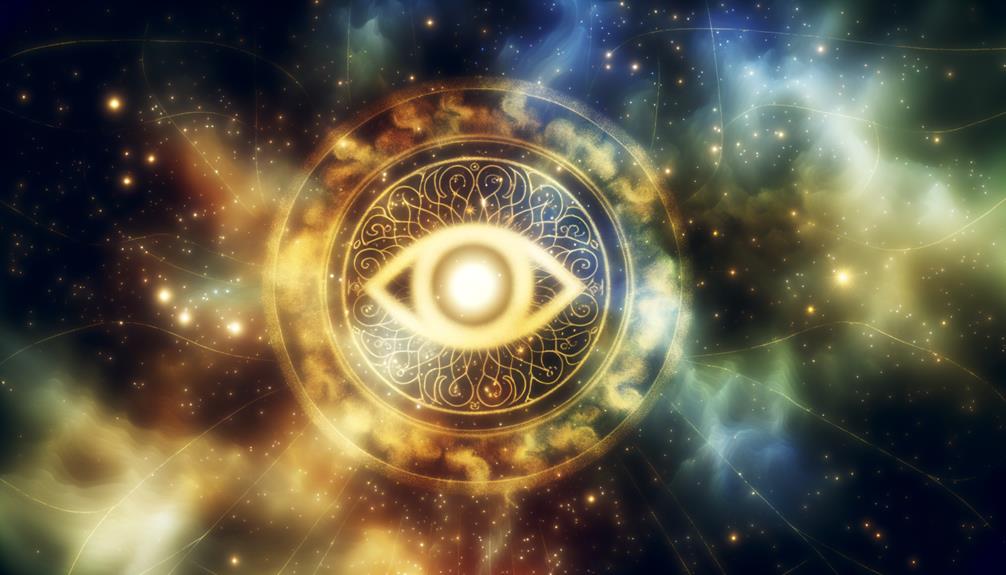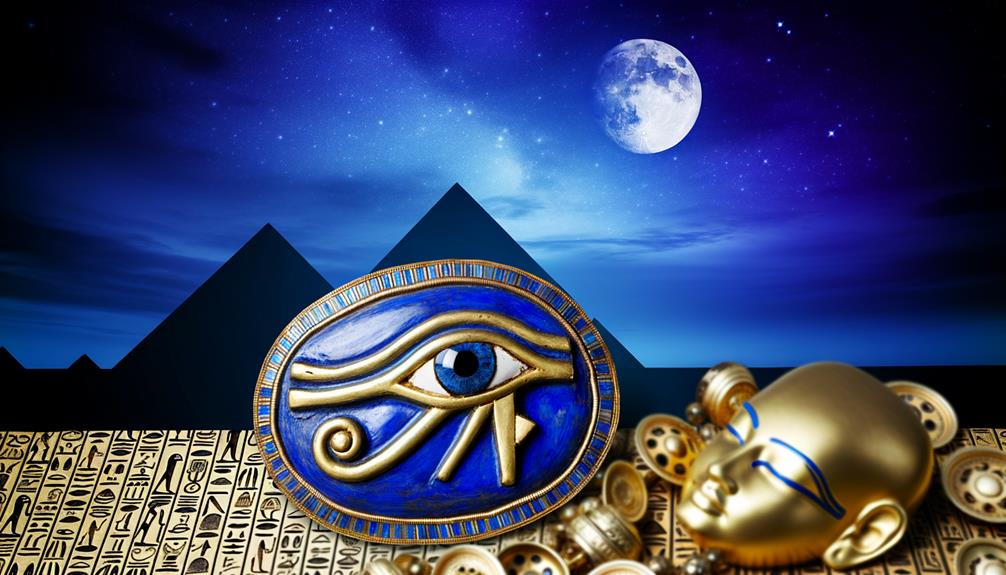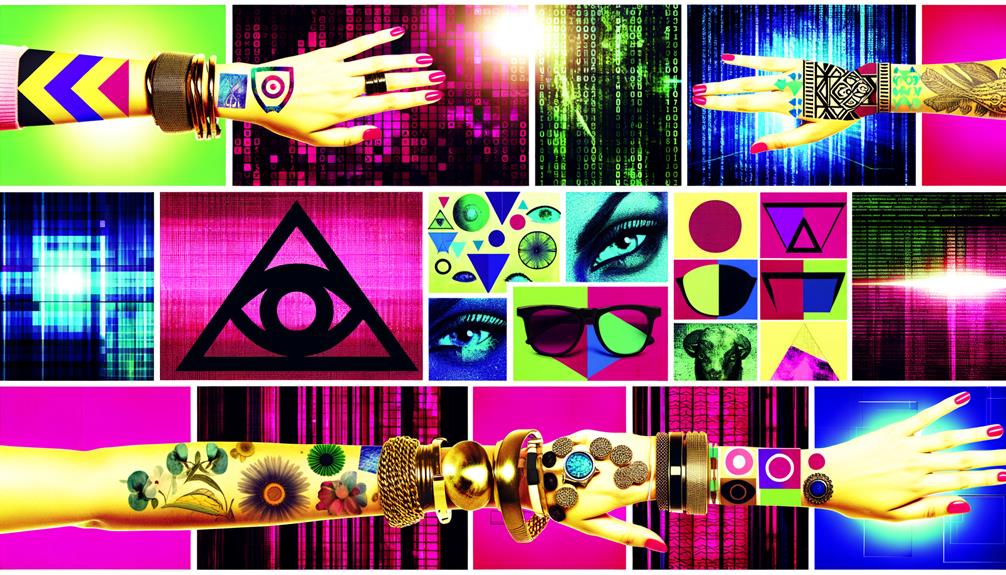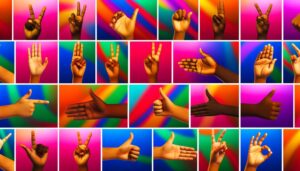What Is the Meaning of the Eye Symbol Across Cultures?
The eye symbol, rich in historical and cultural significance, represents protection, royal power, and health in ancient Egyptian contexts. Religiously, it signifies divine omniscience and inner enlightenment, seen in Christian and Hindu iconography.
Psychologically, it denotes self-awareness and perception. In modern culture, the eye appears in fashion, art, and social media, symbolizing surveillance and human experience.
Artists use the eye to explore themes of awareness, insight, and societal issues. This multifaceted emblem continues to evolve, echoing its ancestral roots while adapting to contemporary narratives.
To uncover its diverse implications further, one must explore its manifestations across various domains.

Key Takeaways
- Represents protection, royal power, and health in ancient Egyptian symbolism.
- Signifies divine omniscience and moral vigilance in religious contexts.
- Symbolizes self-awareness, perception, and the unconscious mind in psychology.
- Used in modern art and media to explore themes of surveillance and truth.
- Represents trust, transparency, and reliability in advertising and branding.
Ancient Egyptian Symbolism

The eye symbol in ancient Egyptian culture, often referred to as the Eye of Horus or the Eye of Ra, embodies a rich tapestry of meanings encompassing protection, royal power, and health. Functioning as a potent hieroglyph, it is meticulously depicted with distinct features, such as the teardrop shape beneath.
Its iconography signifies a divine watchfulness, ensuring the safeguarding of the pharaohs in both life and death. The symbol's association with vision extends to the broader concept of perceiving truth and maintaining cosmic order, or Ma'at.
Its frequent use in amulets and architectural motifs underscores its importance in daily and spiritual life, reflecting a civilization deeply invested in the metaphysical and tangible domains of existence.
Religious Interpretations
Various religious traditions have imbued the eye symbol with profound spiritual significance, interpreting it as a representation of divine omniscience, moral vigilance, and inner enlightenment.
In Christianity, the Eye of Providence symbolizes God's all-seeing eye, underscoring divine supervision over humanity.
Similarly, in Hinduism, the third eye of Lord Shiva signifies spiritual awareness and wisdom, enabling a deeper understanding of the universe.
In Islamic culture, the Hamsa, often depicted with an eye, serves as a protective symbol warding off evil spirits.
Buddhism, too, reveres the eye, particularly in the form of the Buddha's eyes on stupas, which epitomize the watchful, enlightened vision of the Buddha.
Consequently, the eye symbol functions as a potent emblem across diverse faiths.
Modern Cultural Significance

In contemporary culture, the eye symbol has permeated various domains, manifesting prominently in fashion and accessories where it is often embraced as a statement piece.
Artistic interpretations have also adopted the eye motif, using it to explore themes of perception and identity.
Moreover, social media trends frequently feature the eye symbol, signifying its pervasive influence and evolving meaning in modern digital conversations.
Fashion and Accessories
Contemporary fashion has embraced the eye symbol, often referred to as the 'evil eye,' not only as a stylish accessory but also as a potent emblem of cultural and spiritual significance. This multifaceted symbol has found its way into various fashion items, reflecting its enduring relevance and adaptability.
Key areas where the eye symbol is prominently featured include:
- Jewelry: Necklaces, bracelets, and rings often incorporate the eye symbol, blending aesthetics with protective beliefs.
- Clothing: Designers integrate the eye motif into fabrics, creating visually striking and meaningful apparel.
- Footwear: Unique patterns and embellishments featuring the eye symbol add a layer of intrigue to shoes.
- Accessories: Handbags, belts, and scarves adorned with the eye symbol cater to both style and symbolism.
This duality of function and meaning underscores its widespread appeal in modern fashion.
Artistic Interpretations
Beyond its role in fashion, the eye symbol has become a compelling subject in modern art, where its rich cultural significance is explored and reinterpreted through various artistic mediums.
Contemporary artists often imbue the eye with new layers of meaning, reflecting themes such as surveillance, self-awareness, and the omnipresence of digital technology. The symbol's adaptability allows it to transcend cultural boundaries and engage viewers on multiple intellectual levels.
For instance, the eye is frequently used in street art to provoke thought about societal issues, while in digital art, it symbolizes the intersection of human experience and virtual reality. This dynamic reinterpretation underscores the eye's enduring power as a versatile and potent icon in modern cultural discourse.
Social Media Trends
Social media's pervasive influence has transformed the eye symbol into a ubiquitous emblem of self-expression, surveillance, and digital identity. Platforms like Instagram and Twitter have repurposed this ancient symbol, embedding it within the visual lexicon of modern internet culture. Its prominence can be attributed to its multifaceted meanings and adaptability, making it a powerful tool for communication.
- Self-Expression: Users employ the eye symbol in profile pictures, bios, and posts to signify insight or awareness.
- Surveillance: The symbol often represents the omnipresence of digital monitoring.
- Memetic Spread: Its frequent use in memes and viral content underscores its cultural resonance.
- Brand Identity: Companies and influencers leverage the eye symbol to create a sense of mystique and engagement.
This evolution underscores the eye symbol's enduring relevance in contemporary digital spaces.
The Eye in Art
In what ways has the depiction of the eye in art served as a powerful symbol conveying themes of perception, spirituality, and human consciousness across different cultures and historical periods?
Throughout history, the eye has been a potent motif in art, symbolizing insight and divine omniscience. Ancient Egyptian art, for instance, revered the Eye of Horus as a symbol of protection and royal power.
In Renaissance art, eyes often represented the soul's window, reflecting inner truth and human experience. Modern and contemporary artists like Salvador Dalí have used eyes to explore psychological depth and surrealist visions.
This enduring symbol transcends cultural boundaries, consistently evoking profound themes of awareness, spiritual enlightenment, and the quest for understanding in the human condition.
Psychological Perspectives

Understanding the eye as a symbol also necessitates an exploration of its psychological implications, where it profoundly influences concepts of self-awareness, perception, and the unconscious mind. The eye often represents the gateway to one's inner world, offering insights into the depths of the psyche.
In various psychological theories, the eye is a metaphor for:
- Introspection: The eye symbolizes the ability to look inward and reflect on one's thoughts and emotions.
- Perception: It serves as a representation of how individuals interpret and make sense of their surroundings.
- The Unconscious: Jungian psychology associates the eye with deeper layers of the psyche, revealing hidden truths.
- Awareness: The eye signifies heightened consciousness and alertness to both internal and external realities.
These interpretations underscore the eye's multifaceted role in psychological paradigms.
Symbolism in Media
The eye symbol manifests diversely across media, serving as a powerful motif in films, literature, and advertising.
In cinematic narratives, the eye often represents surveillance or insight, while in literary contexts, it can embody themes of perception and awareness.
Meanwhile, in advertising, the eye is frequently utilized to evoke trust and capture consumer attention, highlighting its multifaceted role in shaping audience interpretation and engagement.
Eye in Films
Numerous films utilize the eye symbol as a potent narrative device to convey themes of perception, knowledge, and truth. This emblem often serves as a visual shorthand to explore deeper philosophical questions and character insights.
Directors employ the eye to:
- Represent Surveillance: Illustrating how characters are constantly observed or controlled.
- Symbolize Insight: Depicting a character's journey towards enlightenment or self-awareness.
- Expose Vulnerability: Highlighting moments of emotional or psychological openness.
- Convey Omniscience: Suggesting a god-like awareness or presence within the narrative.
These interpretations enrich cinematic storytelling, allowing filmmakers to communicate complex ideas succinctly.
Eye in Literature
Symbolism of the eye in literature often embodies themes of perception, insight, and the quest for truth, serving as a profound metaphor that transcends mere physical vision.
In classic literature, such as George Orwell's '1984,' the omnipresent eye of Big Brother represents surveillance and control, highlighting the loss of individual freedom.
Similarly, in F. Scott Fitzgerald's 'The Great Gatsby,' the eyes of Dr. T.J. Eckleburg symbolize the moral and ethical void in society, observing the decay of the American Dream.
These literary examples underscore the eye's function as a powerful symbol for deeper psychological and philosophical inquiries, inviting readers to reflect on the nature of observation, knowledge, and the human experience.
Eye in Advertising
Beyond the world of literature, the eye symbol pervades advertising, where it frequently serves as a potent tool for capturing attention and conveying messages of trust, awareness, and vigilance.
This emblematic imagery is harnessed to create an immediate connection with consumers, evoking a sense of being watched or protected. The eye's versatility in advertising can be seen through various lenses:
- Trust: Brands use the eye to symbolize transparency and reliability.
- Awareness: The eye suggests heightened perception and mindfulness.
- Surveillance: It can imply security and constant oversight, appealing to safety-conscious audiences.
- Innovation: The eye often represents foresight and visionary thinking, aligning with cutting-edge technology brands.
Understanding these subtleties helps decode the strategic use of eye symbolism in modern advertising.
Conclusion
To conclude, the eye symbol, steeped in ancient Egyptian roots, has transcended time, permeating religious doctrines, modern culture, and artistic expressions. Its multifaceted significance extends to psychological interpretations and media portrayals.
This emblem, akin to a timeless photograph capturing humanity's collective consciousness, continues to evoke profound insights across diverse fields of study. The eye's enduring presence underscores its universal resonance, reflecting both historical heritage and contemporary relevance in an ever-evolving cultural landscape.





